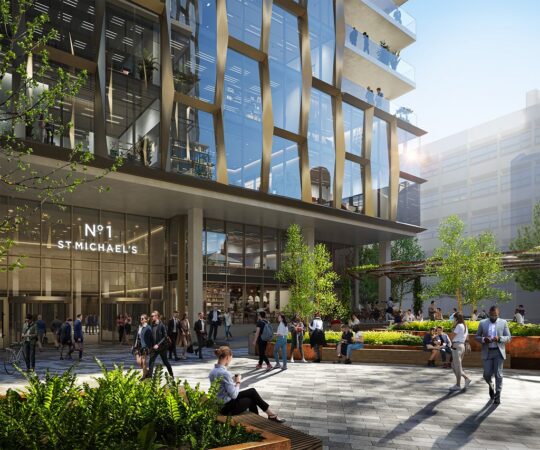IN FOCUS | Will the second half of 2024 be less ‘sticky’ than the first?
Few in property entered 2024 with much hope of a bumper year for the sector. While the predication of a sluggish market has rung true, there is hope on the horizon.
The aftershocks of Liz Truss’s October 2022 mini-budget have died down but the impact of two wars, stubbornly high interest rates, and the freezing effect of a looming general election have forced many to adopt the mantra of “survive until 2025”.
Deals are stuck in legals, viability is tight, and everyone is having to work harder to get anything done.
“It has been very much 2023 vibes,” said Ian Scott, group managing director of residential developer Livingway.
“The word I keep using is sticky. Deals seem to be taking forever.”
Investment
A slower-than-expected reduction in interest rates is the main reason for the stickiness; many had predicted the Bank of England would have cut rates by at least 25bps by now. Instead, the base rate remains at 5.25%, as it has since last summer.
“It’s clear that the pace [of the market] has been more measured than anticipated,” said Alex Russell, chief executive of developer Property Alliance Group.
He said the absence of cuts has resulted in a “cautious investment climate”, with funders adopting a ‘wait-and-see’ approach.
However, Russell thinks the sleepy market might be waking up.
“The frequency and quality of discussions that we are having is on the rise, giving us optimism for deal-making in the near future,” he said.
In the face of a trying economic climate, the North West outperformed the rest of the regions in the first three months of the year, recording £660m of investment deals.
However, acquisitions were down almost 20% nationally in Q1 year-on-year, according to research by CBRE.
The upcoming general election has only served to make the market even gluier.
“We are in a bit of a hiatus at the moment,” said Steve Parry, managing director of Liverpool-based Ion Developments. “Funders are waiting for the outcome of the election. Pinning people down has been a challenge.”
Investment figures for Q2 are still being worked up but Rishi Sunak’s rain-soaked general election announcement in May means they are likely to paint a similar picture to the first three months of the year.
Dealmakers, we are told, have priced in a Labour win but are still reluctant to pull the trigger.
Ian Scott is confident that a new government with a large mandate could be the proverbial acetone to unstick the market.
He believes that those with money to spend will use the months post-election to strategise before deploying capital towards the end of the year.
“I feel like there’ll be some momentum after the summer,” he said. “You could see a really big Q4.”
Jonathan Mills, co-founder of Metis Real Estate, can also see the light at the end of the investment market tunnel.
However, he thinks it may take a bit longer for investors to shake off the shackles.
“We have been searching for the bottom of the market and I think we have found it,” he said. “I think we are going to bounce along the bottom for a little bit.
“We are going to see an increase in [investment] volumes but nothing meteoric. There will be more activity next year but there is nothing to suggest it is going to go tonto post-election.”
A new government
Beleaguered by the instability and constant curve balls of recent years, the industry is looking for a solid foundation to build upon.
The built environment community has shuffled its way through the first six months of the year and will be hoping any new government’s first 100 days provide enough confidence for it to put its best foot forward.
“Early noises around the affordable housing programme will be fascinating,” said Helen Spencer, head of executive director of growth at Great Places Housing Group.
It is a tough time for housing associations right now. They find themselves caught between the two stools of retrofitting existing stock and trying to deliver new-build units to make a dent in ever-growing housing waiting lists.
Great Places is more active than the majority of registered providers when it comes to acquiring land and announcing new schemes – just last month it acquired 51 homes across schemes in Manchester and Rochdale – but it is still a struggle out there.
“We are having to show resilience and creativity to make anything work,” Spencer said.
“It is still extremely challenging and balancing affordability and viability is still the hardest piece to put together. Construction costs are more predictable but they have not fallen.”
Despite the economic and political waves that have battered the affordable housing sector in recent years, Spencer is hopeful that the second half of the year will bring with it calmer waters.
“You don’t really want to say it out loud in case you curse it but we are feeling more optimistic,” she said.
More broadly, the question on every property professional’s lips is what would a new government do about planning?
Melanie Leech, chief executive of the British Property Federation, would like to see whoever gets into power bolster the existing system rather than ripping up the playbook completely.
“I’m not naive enough to think that means every local authority is going to get 10 planners [but] putting more resources into planning needs to happen,” she said.
Planning will be just one issue in a large pile the incoming government will have to deal with if it secures the massive majority many are predicting.
If polls are correct and Labour prevails by a significant margin, what the party chooses to prioritise will have a huge bearing on how successful it is in keeping around 200 new MPs and their constituents happy.
The key to this may lie in placing more trust in local authorities when it comes to funding.
Leech describes the Tories’ current approach to funding as “bureaucratic, tightly constrained, and controlled from the centre”.
“I suspect that if you gave that same amount of money to a local authority and said, ‘you know your area best, you spend it’, they could spend 100 pence of the pound,” she said.
Simon Bedford, founder of Bedford Advisory and ex-partner at Deloitte, agrees that we may see a different approach to funding under a new government.
Bedford is predicting a “subtle shift” away from current funding priorities, which have seen the Tories hone in on town centres.
The focus under Labour would be on growth, Bedford said. This means backing strategic sites with the potential to create jobs – think Atom Valley – and perhaps less emphasis on revitalising ailing high streets.
“It is about looking around the North West, Yorkshire, Humberside, and the North East and asking where we are going to get the biggest bang for our buck,” Bedford said.
Like many others, he is predicting a comparatively positive second half of the year.
“I think you’ll see a big uptick in optimism post-July 4,” he added. “That’s the way the property industry works, it thrives on hope.”
Office outlook
Whether you’re a developer, consultant or investment agent, the sentiment seems to be the same: things have been tough but they’re improving.
Try telling that to the office market.
Best in class, new stock is still in demand from occupiers. Gary Neville’s St Michael’s, which is under construction, has secured four tenants so far, breaking Manchester’s headline rent record twice in the process.
S&P Global will pay £44 for each of its 20,000 sq ft, proving that occupiers are willing to pay a premium for the right space. Agents reckon the city could break £50/sq ft in the not-too-distant future.
However, for every St Michael’s, there are two or three older buildings failing to attract tenants and in need of upgrades worth millions of pounds.
Landlords are looking at the cost of refurbs against the projected rental return with furrowed brows.
Older offices are albatrosses around their owners’ necks – presenting an opportunity for innovators and opportunists – and the prospect of building new is even worse.
‘Sticky sounds like something that might be unstuck. I don’t think this market will become unstuck,’ Mike Ingall
Rents for best-in-class assets may be on the rise but the cost of building and borrowing remains high, sometimes prohibitively so.
For that reason, the view of agents and developers Place has spoken to is that the days of speculative office development are over for now.
The chances of securing the kind of pre-let that would de-risk an office scheme are slim. Manchester has recorded just one letting above 100,000 sq ft in the last three years.
Meanwhile, Liverpool’s Pall Mall, a site earmarked for 400,000 sq ft of offices, has been waiting for a pre-let for almost five years.
In April, Martin Property Group announced plans to build more than 500,000 sq ft of offices at Fishergate in Preston. In the current market, this seems like little more than a pipe dream.
“I think the prospect of any new commercial development at the moment is quite remote,” said Mike Ingall, chairman and CEO of Allied London.
Ingall cites significant structural changes in the way we work, including the rapid adoption of tech, as reasons the office market will not bounce back in the way many people expect.
“We had a sustained spell of working from home, it has advanced something that was going to happen anyway. You can’t unsee it and you can’t forget it,” he said.
Sticky is one of many similar words people are using to describe the current market. Ingall thinks it is more serious than that.
“Sticky sounds like something that might be unstuck,” he mused.
“I don’t think this market will become unstuck. I think we need to leave the sticky thing alone and start again.”
Amid the uncertainty, the flexible workspace sector continues to capitalise.
Gilbanks signed for a second Manchester site earlier this year, taking 35,000 sq ft at St Michael’s, while Cubo acted quickly to snap up the 60,000 sq ft vacated by WeWork in Spinningfields.
In Preston, OneCoWork signed up to operate a 32,000 sq ft space off Winckley Square.
BTR bucks the trend
While the head-scratching around offices looks set to continue for some time, one sector that has continued to strengthen is build-to-rent.
Underpinned by chronic undersupply, this asset class has continued to attract funding across the North throughout the first half of the year while others have struggled.
According to Knight Frank, investment in BTR during Q1 of 2024 was up 20% year-on-year.
Moorfield re-entered the build-to-rent space with a nine-figure funding deal for Glenbrook’s Lumina Village, comprising 440 apartments in Old Trafford, while Heim Global Investor has partnered with McLaren Living on BeckYard, a 375-home build-to-rent development in the South Bank regeneration area of Leeds.
In Newcastle, investor Hines will forward fund Olympian Homes’ 519-apartment Pottery Lane scheme to the tune of £121m.
Rents across the living sector continue to rise as demand outstrips supply, which means homes in cities like these are an attractive prospect for buy-to-let investors.
“There is a big opportunity there in terms of the under supply,” said Adam Price, chief executive of Select Property.
“Property values and price/ sq ft still offer good value for money, especially compared to London, and the rental yields are strong; the rents we’re achieving are anywhere from 6%, up to 7.5%.”
Select is “reviewing opportunities” Manchester and Birmingham, its favourite UK cities, but is no hurry to do a deal if it doesn’t stack up.
Land values – more specifically the demands of landowners – are still a sticking point.
“As it stands, we haven’t seen much movement on land prices, hence the reason why we haven’t been able to commit to anything,” Price said.
Industrial insights
It is a different story in the world of sheds.
Industrial land values corrected dramatically in 2022 as yields moved out post-pandemic. Last year and into in 2024, the market has seen them bottom out and stabilise, presenting an opportunity for acquisitive developers.
“I think the market is looking at the current situation and saying ‘we think we’re at the bottom end of it and we think it’s going to get stronger,” says Kate Howe, development director at Tritax Symmetry.
“Now is the time to bid to take advantage of the land values as they are now.”
Like the residential sector, the industrial market is undersupplied, especially when it comes to units larger than 100,000 sq ft.
While transactional activity has been slow so far this year, Howe thinks the supply and demand dynamic that underpins the industrial market will ensure things pick up in the coming months.
If that turns out to be true, we may see more deals like KKR and Mirastar’s £100m acquisition of Mountpark’s 740,000 sq ft shed in Warrington, which was the highlight of industrial investment in the first half of the year.
Such is Tritax’s confidence in the market, the developer is delivering the second unit at its Symmetry Park Merseyside scheme on spec – the first was pre-let to Yodel and completed earlier this year.
Tritax, which is backed by the £6bn Tritax Big Box REIT, also spent big on a 221-acre plot of land in St Helens last year. The developer is planning to build 2.5m sq ft of industrial space and a freight terminal.
“We are quite comfortable in the market at the moment,” Howe said.
“To take on an acquisition of that type and going forward with speculative builds should prove that we’ve got confidence. I think that shows where we’re sitting.”
Local authority perspectives
Local councils are generally optimistic too, at least outwardly. Despite continued cuts, the North West’s authorities are muddling through and pushing ahead with major projects.
Even Warrington, under scrutiny from government for amassing a £1.8bn pile of debt, is bullish. Chief executive Steven Broomhead recently told Place he is looking forward to “justifying the decisions of the council” when he comes face to face with Whitehall officials.
“We’ve been borrowing money for regeneration. What the hell is wrong with that?” he said.
While the private sector waits for the market to pick up, the public sector is cracking on. It has to, many of its regeneration projects are reliant upon government funding, which has tight deadlines.
Expect news on Manchester City Council’s plans for Wythenshawe and Salford’s Eccles revamp in the second half of the year.
Despite facing “dwindling funding from central government,” Salford City Council’s chief executive is optimistic about the city’s fortunes.
“Salford continues to experience challenges and as a local authority we’re no different than others up and down the country,” he said.
“It is an exciting time and the commitment remains to meet the needs of our residents and businesses. The goal is creating places where people want to live, work, visit, and continuing to deliver that beneficial, sustainable growth.”
Salford has long been viewed as a proactive authority in terms of regeneration, Liverpool City Council is hoping it will soon be able to say the same.
Government-appointed commissioners have left the authority and the city’s development community, and outside investors, will be watching closely in the second half of the year.
Coming unstuck
The property professionals Place spoke to are not naive enough to think that a change in government will bring with it sweeping reforms that transform 2024 from bear to bull. Or that a slight reduction in the cost of borrowing will turn frowns upside down.
Interest rates will come down but slowly, office values will not rebound overnight, if ever, and investors will remain circumspect for some time.
But there is more than a little hope that the worst is over, that the market may unstick itself one deal at a time, and that we all might, as the mantra goes, survive to see 2025 after all.








